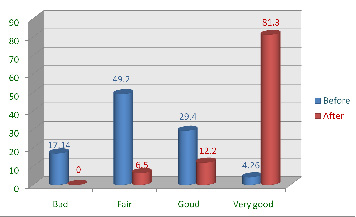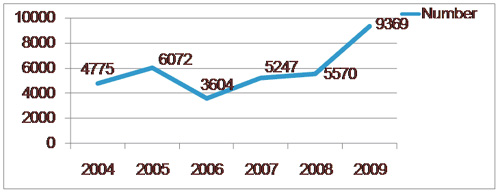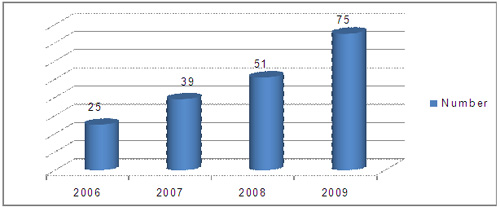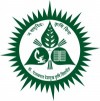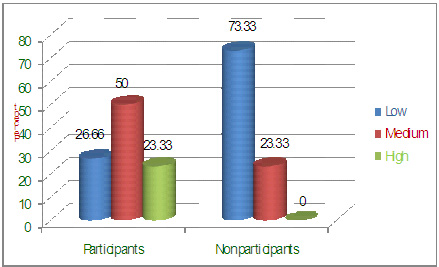Researchers
Dr. Vijay K. Mahorkar, Director of Extension Education
Niteen R. Koshti, Chief Extension Education Officer
Dr. Kailas T. Lahariya, Assistant Professor
Methodology Adopted for all Evaluations
Theme of research: Group Dynamics
Sub Theme: Impact Assessment
| 1. What is Evaluated? Ans. University Extension Education Programmes 2. Purpose of Evaluation Ans. To assess the impact of ongoing Extension Programmes / activities on selected Indicators. 3. Who will use the evaluation? How will they use it Who / users How will they use the information 4. How others involved in the evaluation. 5. What questions will the evaluation seek to answer ? |
| What I wish to Know | Indicators-How I knew it. |
| Knowledge changes | Suitable scale / tests |
| Adoption | Suitable scale / tests |
| Constraints | Ranking |
| Personal Attributes | Self Rating scale |
| Satisfaction | Scale of Haque 1981 |
|
7. When is the evaluating needed. time, money. 9. What sources of information will you use. 1) Exploratory design |
|
Method |
Before programme |
During Programme |
Immediately after |
later |
|---|---|---|---|---|
| Interview Schedule |
Yes
|
Yes
|
||
| Questionaire |
Yes
|
Yes
|
|
12. How is data analyzed ? 13. Who is responsible :- Investigators |
| To whom | When / where / how to present |
| Sponsoring agencies | As an when required |
| Scientists | As an when required |
| Government | As an when required |
| 16. Implementation plan :- Timeline and responsibilities 17. Management chart :- One year 18. Budget :- Not Applicable. |
Krishak Vigyan Manch
Krishak Vigyan Manch organized by KVK’s
|
Sr. No. |
Name Of KVK& District |
Number of KVM Organized |
Number of Registered farmers |
|---|---|---|---|
|
1 |
KVK, Ghatkhed Dist. Amravati |
29 |
3413 |
|
2 |
KVK, Sindewahi Dist. Chandrapur |
29 |
1317 |
|
3 |
KVK, Sonapur Dist. Gadchiroli |
29 |
1161 |
|
4 |
KVK, Selsura, Dist. Wardha |
29 |
1069 |
|
5 |
KVK, Sakoli Dist. Bhandara |
29 |
745 |
|
6 |
KVK, Yavatmal, Dist. Yavatmal |
29 |
1037 |
|
7 |
KVK, C.I.C.R. Nagpur |
19 |
565 |
|
8 |
KVK, Hiwara, Dist. Gondia |
27 |
500 |
|
9 |
KVK, Jalgaon Jamod Dist. Buldhana |
29 |
921 |
|
10 |
KVK, Karda Dist. Washim |
29 |
1005 |
|
|
Total |
278 |
11733 |
* Number of farmers registered – 19303.
Krishi Vigyan Manch Impact
Farmers visiting KVM based on distance of their villages from KVM
|
Distance in KM |
Percent farmers |
|---|---|
|
<10 |
— |
|
11 – 10 |
20.00 |
|
21 – 30 |
6.66 |
|
31 – 40 |
10.00 |
|
41 – 50 |
36.67 |
|
> 51 |
26.67 |
Frequency of visit in KVM
|
Frequency of attendance |
Number |
Percent |
|---|---|---|
| Up to 5 | 10 | 33.33 |
| 5 to 10 | 03 | 10.00 |
| 10 to 15 | 05 | 16.67 |
| 15 to 20 | 02 | 6.67 |
| 20 to 25 | 03 | 10.00 |
| 25 to 30 | — | — |
| 31 to above | 07 | 23.33 |
Knowledge level of the participants and non-participants
|
Sr |
Categorization |
Participants |
Non Participants |
||
|---|---|---|---|---|---|
| 1 | Low knowledge (Answered up to 13 out of 39 questions) |
F | %0 | F | % |
| 08 | 26.66 | 23 | 73.33 | ||
| 2 | Medium knowledge (Answered between 14 to 26 out of 39 questions) |
15 | 50.00 | 07 | 23.33 |
| 3 | High knowledge (Answered 27 and above out of 39 questions) |
07 | 23.33 | 00 | 0.00 |
| Mean | 20.7 | 11.2 | |||
| SD | 7.9 | 5.2 | |||
| Range | 6-36 | 1-25 | |||
| t value | 14.9** | ||||
Knowledge level of the participants and non-participants
|
Sr. No. |
Tips |
Practicising prior to KVM participation |
Began Practicising after KVM participation |
Intend to practice in the future |
No plans to adopt |
||||
|---|---|---|---|---|---|---|---|---|---|
|
F
|
%
|
F
|
%
|
F
|
%
|
F
|
%
|
||
| 1 | Selection of Soil (Well drain ph ranging 6.5 to 7.5 ) |
02
|
3.33
|
26
|
43.33
|
09
|
15.00
|
—
|
—
|
| 2 | Seed treatment 3 gm Thirum / kg 1 gm Carbendizum / kg 4 gm Tricoderma / kg |
02
|
3.33
|
27
|
45.00
|
31
|
51.66
|
—
|
—
|
| 3 | Seed treatment with biofertilizers ( Rhizobium (J ) + PSB 250 gm/10 kg ) |
02
|
3.33
|
27
|
45.00
|
31
|
51.66
|
—
|
—
|
| 4 | Sowing time third week of June to 2nd week of July or after 75 to 100 mm rains |
53
|
88.33
|
07
|
11.66
|
—
|
—
|
—
|
—
|
| 5 | Sowing method Depth – not more than 4 cm across the slope |
10
|
16.66
|
32
|
53.33
|
09
|
15.00
|
—
|
—
|
| 6 | Seed rate 30 kg per acre |
57
|
95
|
03
|
5.00
|
—
|
—
|
—
|
—
|
| 7 | Fertilizer application 30 kg N and 75 kg P |
02
|
3.33
|
39
|
65.00
|
21
|
35
|
—
|
—
|
| 8 | Intercrops Tur-Soybean (1:2 or 2:4) |
47
|
78.33
|
12
|
20
|
01
|
1.66
|
—
|
—
|
| 9 | Weed management Before Sowing Basalin 45 %, Treflon 48 % Pre-emergence Lasso 50 %, Metachlor Dual 50 % |
02
|
3.33
|
29
|
48.33
|
29
|
48.33
|
—
|
—
|
Perceived Impact of KVM on individual abilities of the farmers, farm women (N=60)
|
Atributes |
Mean before KVM |
Mean after KVM |
Difference in levels attended by respondents |
Paired t value |
|---|---|---|---|---|
| Self confidence | 3.57 | 8.40 | 4.83 | 16.8* |
| Leadership level | 3.55 | 8.50 | 4.95 | 18.2** |
| Social Relationship Developed | 3.35 | 8.58 | 5.23 | 17.2** |
| Decision making ability | 3.47 | 8.33 | 4.88 | 18.3** |
| Economic freedom level | 4.25 | 8.20 | 3.98 | 12.7** |
| Freedom of expression | 4.40 | 8.53 | 4.15 | 14.6** |
| Identity as an individual | 3.77 | 8.62 | 4.85 | 17.1** |

- Co-ordination among different division in the University is strengthened.
- Farmer-scientist and farmer-farmer-scientist linkages developed
- Feed-back received from farmers helps to researchers for refinement of agricultural technologies.
- Farmers participation in the university organised programme is increasing.
Workshop on “Role of Media in Agricultural Extension”
Recommendations
- Frequent gathering is required for TOT by SAU, SAD & Media Personnel
- Technology Generation and Technology Transfer should go simultaneously
- There should be 24 hour Agricultural Channel in public sector
- There should be Head line coverage about Agriculture
- Media should verify success stories on its economics
- Training on writing quality, reliable and correct information by writers, editors and reporters should be arranged
- Developmental policies of Government for rural sector should bring for understanding before initiation through media
- Such Workshops should be arranged for District and Taluka level media personnel by involving progressive farmers, media and scientists
- Training to the agricultural scientists/needed on writing the articles that will be acceptable by media
- Practical utility of technology on farmers fields shall be focused on front page of newspapers
- Organize special workshops / trainings for rural mass media workers so that they can focus the grass root problems of farmers.
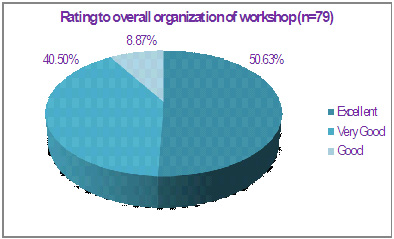 |
Conclusions
|
Shivar Pheri
Main Findings …
| *Sixty nine percent farmers get aware about Shivar Pheri from Newspapers. Thirty one percent obtained information from State Department of Agriculture and friends respectively. |
| *Seventy three percent farmers visited Shivar Pheri at their own pocket expenses. This clearly indicates that interest & confidence of Farmers in the University activities. |
| *Ninety percent farmers quoted their objective in coming Shivar Pheri were to acquire knowledge on New Agricultural Technologies. 10 percent farmers showed their interest in purchasing seed and other things. |
| *Thirty nine percent farmers reported that their objectives in attending Shivar Pheri were completely met. Sixty one percent reported that their objectives were met to some extent. |
| *Seventy one percent farmers expressed high satisfaction towards time allotted for Charcha Satra. Sixty three percent expressed satisfaction over the replies given by the scientists. |
| *Fifty percent gain in knowledge about new agricultural technologies was noticed in case of Seventy three percent farmers due to interaction with scientists on field and Charcha Satra. |
Sample Views …
| *Received lot of information in lesser time- Shri. Avinash Kanhaiyalal Hatwar, Bhandara |
| *Upgradation of knowledge in Shivar Pheri will definitely change the life of farmers- Shri. Mukinda Bhade, At. Post: Jamb, Tq: Samudrapur, Dist: Wardha |
| *Shivar Pheri should be organized twice in a year- Shri. Jugalkishore Pimple, At. Mundgaon,Tq. Akot, Dist: Akola |
| *Publicity is less. Information should reach into village- Shri. Rajesh B. Khambalkar, At. Gorwha, Dist: Akola |
| *Mini Charcha Satra should be arranged on respective spots- Shri. Chandrashekar Bapurao Mohad, At.Khandala, Dist: Akola |
| *I am completely satisfied with the organization & guidance provided by the scientists of University during Shivar Pheri-Shri. Gyaneshwar P. Ingle, At. Karla, Dist: Akola |
| *Some tips noted during Shivar Pheri & hopefully will prove beneficial in future- Shri. Bhojraj T. Sarode, At. Godhani Rly. Dist: Nagpur |
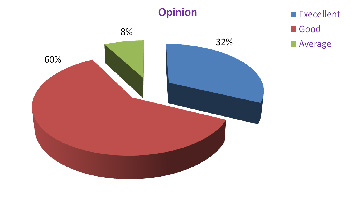
Opinion of farmers about Shivar Pheri (n=169)
Kirtankar Mela
Details of Kirtankar / Pravachankar Mela
|
Sr. No. |
Name of KVK and District |
Date on which Mela organized |
No. of Participants (Kirtankar/ Pravachankar) |
|---|---|---|---|
| 1 | KVK Ghatkhed, (Amravati) | 05.09.2009 | 71 |
| 2 | KVK, Sindewahi, (Chandrapur) | 05.09.2009 | 95 |
| 3 | KVK, Sonapur, (Gadchiroli) | 05.09.2009 | 76 |
| 4 | KVK Selsura, (Wardha) | 05.09.2009 | 84 |
| 5 | KVK, Sakoli, (Bhandara) | 05.09.2009 | 550 |
| 6 | KVK, Yavatmal, (Yavatmal) | 05.09.2009 | 295 |
| 7 | KVK ,Durgapur, (Amravati) | 05.09.2009 | 63 |
| 8 | KVK Hiwara, ( Gondia) | 05.09.2009 | 120 |
| 9 | KVK, Jalgaon, Jamod (Buldhana) | 05.09.2009 | 285 |
| 10 | KVK, Karda, (Washim) | 05.09.2009 | 53 |
| 11 | Dr. PDKV, Akola | 05.09.2008 | 350 |
| Total | 2042 |
Impact of Kirtankar Mela …Some Cases
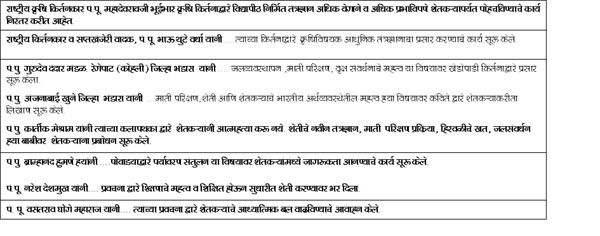
Training of Krishi Doots
Details of Krishi Doot Trainings
|
Sr. No. |
Name of KVK and District |
Number of Training programmes |
Number of Krishidoots trained |
|---|---|---|---|
| 1 | KVK Ghatkhed Dist. Amravati | 04 | 79 |
| 2 | KVK, Sindewahi Dist. Chandrapur | 07 | 100 |
| 3 | KVK, Sonapur Dist. Gadchiroli | 05 | 45 |
| 4 | KVK Selsura, Dist. wardha | 06 | 503 |
| 5 | KVK, Sakoli Dist. Bhandara | 15 | 564 |
| 6 | KVK, Yavatmal, Dist. Yavatmal | 19 | 1910 |
| 7 | KVK, CICR Nagpur | 01 | 51 |
| 8 | KVK Hiwara, Dist. Gondia | 18 | 1109 |
| 9 | KVK, Durgapur, Dist. Akola | 01 | 32 |
| 10 | KVK, Jalgaon Jamod Dist. Buldhana | 07 | 99 |
| 11 | KVK, Karda Dist. Washim | 06 | 150 |
|
Total
|
89 | 4642 |
Achievements of Krishi Doot Trainings
| The trained Krishi Doots from different villages have started different Units by forming groups at village level with the guidance of KVK Selsura. |
| Krishi Doots are sending trainees for specialized trainings organized by KVKs. |
| Krishi Doots are acting as strong linkage between KVK scientists and farmers. |
| Vinay Mahajan and Shri. Shankar Bhoyar, trained Krishi Doots of Isapur ,Dist. Wardha have started the seed production programme of coriander and fenugreek. |
| Shri. Mukul Pathak of Dist. Wardha has started commercial drumstick nursery. |
| Shri. Vaibhav Ughade of Dist. Wardha has started intensive cultivation of capsicum under net house. |
| Krishi Doots have taken lead in formation of 23 farmers club in Gondia Distrist. |
Agriculture Technology Information Centre (ATIC)
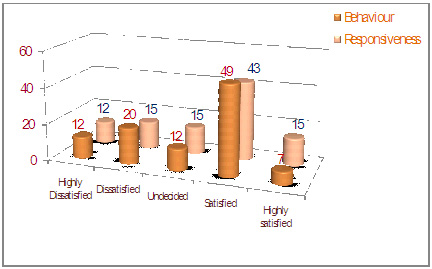
Satisfaction with Behaviour of ATIC Staff (n=41)
|
Response Category |
Highly Dissatisfied |
Dissatisfied |
Undecided |
Satisfied |
Highly Satisfied |
|---|---|---|---|---|---|
| Behaviour | 12 | 20 | 12 | 49 | 07 |
| Responsiveness | 12 | 15 | 15 | 43 | 15 |
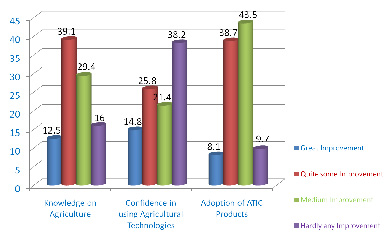
Impact on Visitors (Degree of Improvement %) (n=41)
|
Indicators |
Great Improvement |
Quite some Improvement |
Medium Improvement |
Hardly any Improvement |
|---|---|---|---|---|
| Knowledge on Agriculture |
12.5
|
39.1
|
29.4
|
16.0
|
| Confidence in using Agricultural Technologies |
14.8
|
25.8
|
21.2
|
38.2
|
| Adoption of ATIC Products |
8.1
|
38.7
|
43.5
|
9.7
|
| Frequency of visiting ATIC (n=41) | ||||||||||||||||||||||||||
 |
|
|||||||||||||||||||||||||
| Types of Enquiries made at ATIC (2009-10) | ||||||||||||||||||||||||||
|
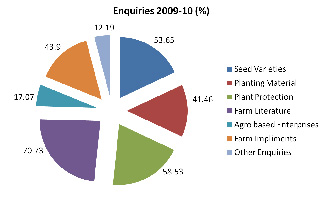 |
|||||||||||||||||||||||||
| * Sum of percentage is more than 100 due to multiple responses |
Agricultural Exhibition 2009, Gondia
|
Sr. No. |
Objective |
Frequency |
Percent |
|---|---|---|---|
| 1 | To know Government Schemes | 06 | 1.30 |
| 2 | To acquire new knowledge | 423 | 92.16 |
| 3 | To purchase seeds | 15 | 3.27 |
| 4 | To purchase something new | 15 | 3.27 |
|
Sr. No. |
Rating |
Frequency |
Percent |
|---|---|---|---|
| 1 | Outstanding | 40 | 8.71 |
| 2 | Excellent | 312 | 67.97 |
| 3 | Good | 45 | 9.8 |
| 4 | Average | 31 | 6.75 |
| 5 | Poor | 31 | 6.75 |
|
Sr. No. |
Satisfaction indicators |
Degree of Satisfaction (n=459) |
% level of satisfaction |
||
|---|---|---|---|---|---|
|
Highly satisfied |
Moderately Satisfied |
Least satisfied |
Percent |
||
| 1 | Topics of Charcha Satra | 289 | 102 | 68 | 82.71 |
| 2 | Resource persons | 180 | 159 | 80 | 60.85 |
| 3 | Time allotted for Charcha Satra | 170 | 206 | 83 | 60.85 |
| 4 | Answer to queries | 182 | 216 | 61 | 62.23 |
